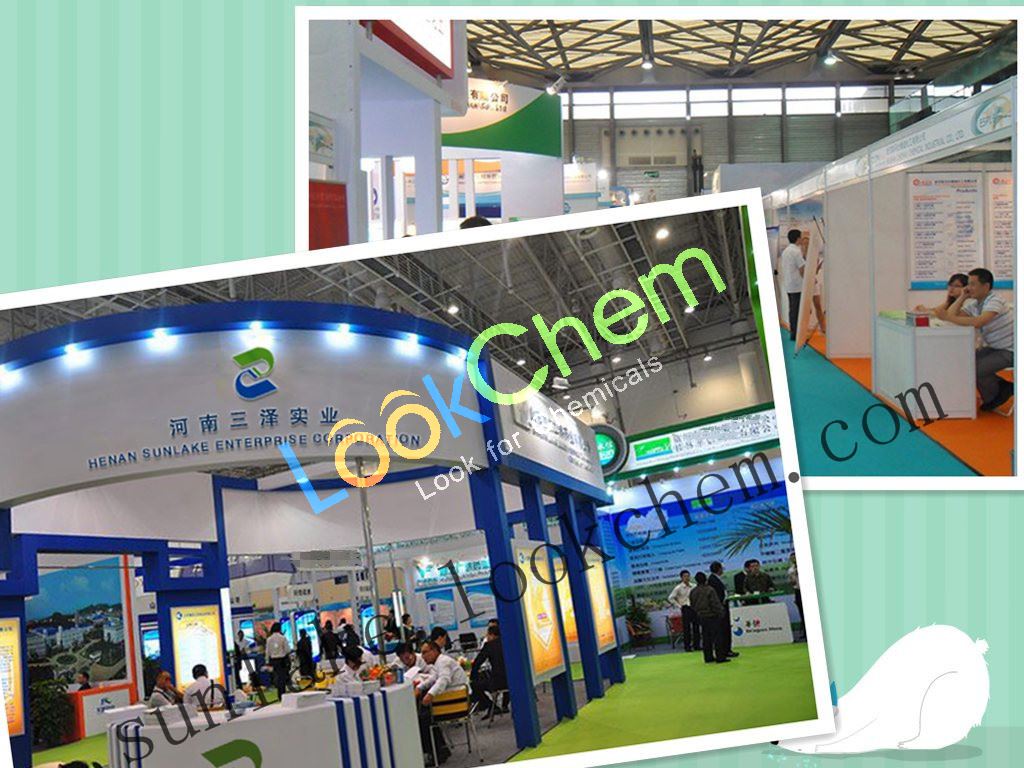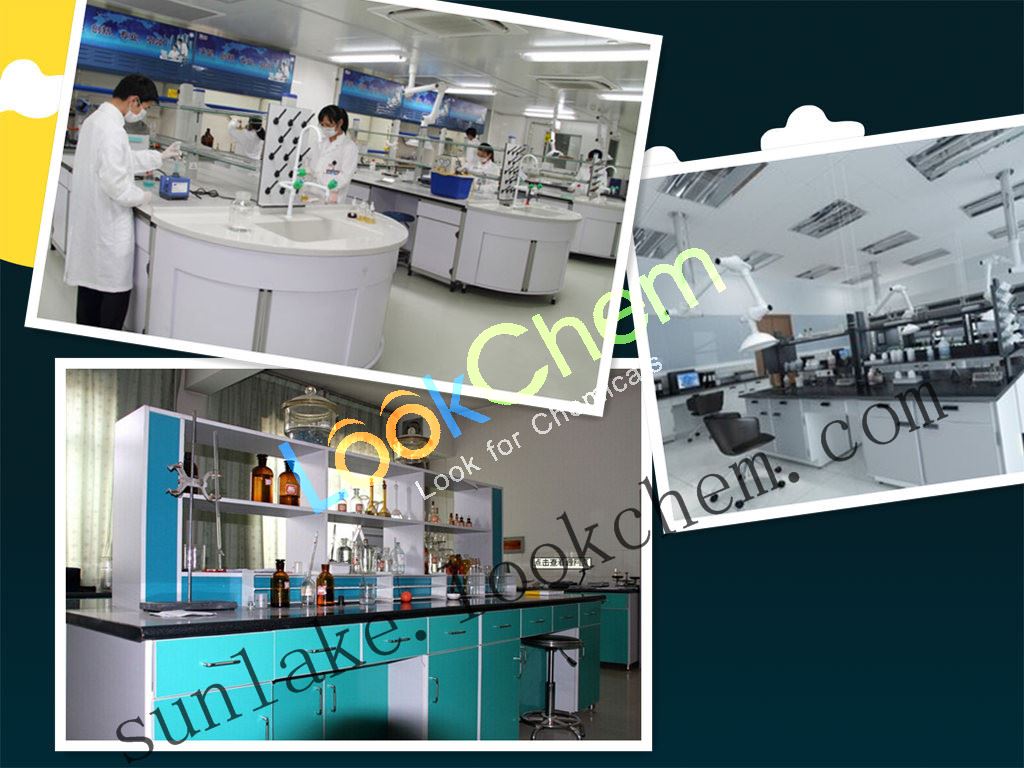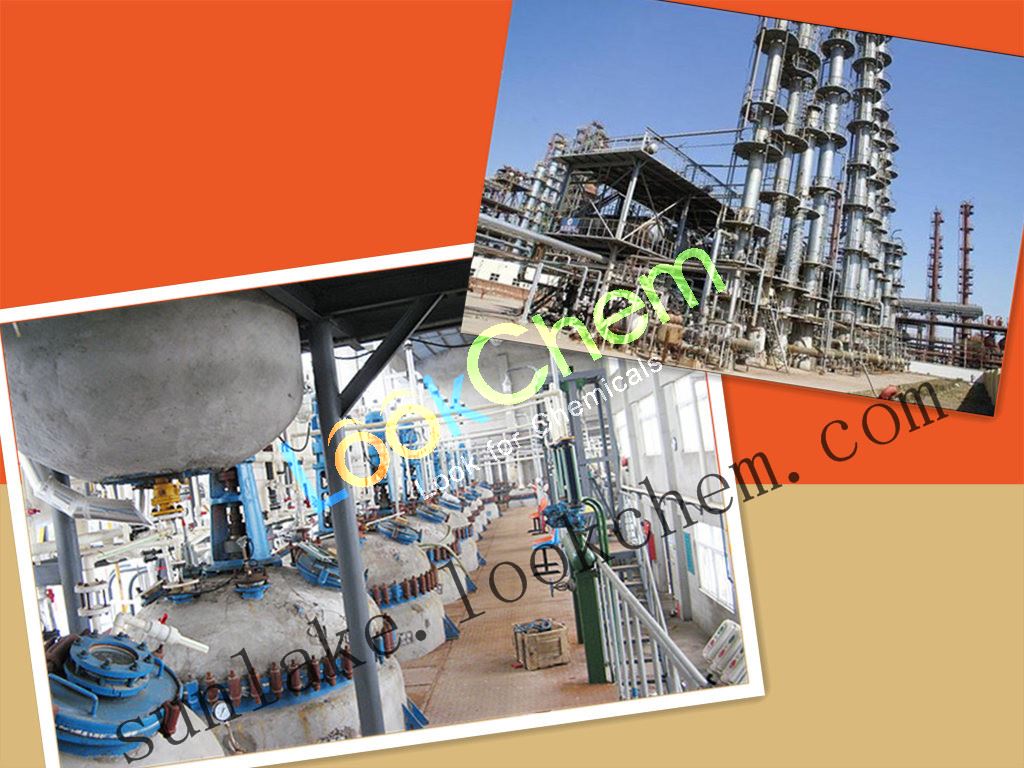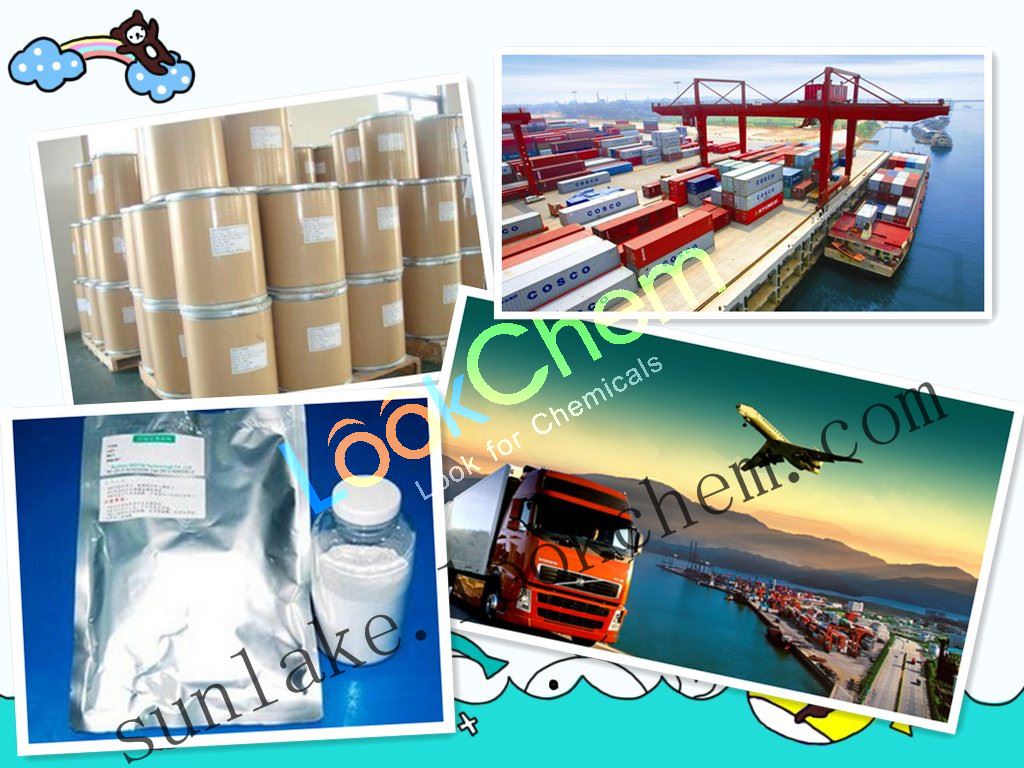HENAN SUNLAKE ENTERPRISE CORPORATION
- Country:
 China (Mainland)
China (Mainland) - Year Established: 2010
- Business type: Trading Company
- Contact Details | Similar Products


You May Like:
-
-
-
-
lower price High quality B-[ CAS No.: 1189047-28-6
USD $1.00-1.00 / Kilogram
-
lower price High quality 9-( CAS No.: 2148296-04-0
USD $1.00-1.00 / Kilogram
-
lower price High quality 9-( CAS No.: 2707470-64-0
USD $1.00-1.00 / Kilogram
-
lower price High quality Bor CAS No.: 179381-09-0
USD $1.00-1.00 / Kilogram
-
lower price High quality 3-A CAS No.: 3112-01-4
USD $1.00-1.00 / Kilogram
-
lower price High quality 4-A CAS No.: 50548-43-1
USD $1.00-1.00 / Kilogram
Chloramphenicol 56-75-7 CAS NO.56-75-7
- Min.Order Quantity:
- 100 Kilogram
- Purity:
- 99%
- Port:
- China Main Port
- Payment Terms:
- L/C,D/A,D/P,T/T,MoneyGram,Other
Keywords
- RARECHEM AH PB 0251
- 56-75-7
- C11H12Cl2N2O5
Quick Details
- ProName: Chloramphenicol 56-75-7
- CasNo: 56-75-7
- Molecular Formula: C11H12Cl2N2O5
- Appearance: powder
- Application: 56-75-7
- DeliveryTime: Within 3-7 days
- PackAge: Depended
- Port: China Main Port
- ProductionCapacity: 300 Kilogram/Month
- Purity: 99%
- Storage: Refrigerator
- Transportation: by air or by sea
- LimitNum: 100 Kilogram
- Valid Period: 6 month
- Application: Multipurpose intermediate
- Application: ISO/9001 Certificate
Superiority
| chloramphenicol basic information |
| product name: | chloramphenicol |
| synonyms: | ,[theta-(theta,theta)]-;[r-(r*,r*)]-2,2-dichloro-n-[2-hydroxy-1-(hydroxymethyl)-2-(4-nitrophenyl)ethyl]ethanamide;2,2-dichloro-n-(2-hydroxy-1-(hydroxymethyl)-2-(4-nitrophenyl)ethyl)-acetamid;2,2-dichloro-n-[2-hydroxy-1-(hydroxymethyl)-2-(4-nitrophenyl)ethyl]-,[r-(r*,r*)]-acetamide;2,2-dichloro-n-[2-hydroxy-1-(hydroxymethyl)-2-(4-nitrophenyl)ethyl]-acetamid;acetamide, 2,2-dichloro-n-(beta-hydroxy-alpha-(hydroxymethyl)-p-nitrophenethyl);acetamide, 2,2-dichloro-n-[2-hydroxy-1-(hydroxymethyl)-2-(4-nitrophenyl)ethyl]-, [r-(r*,r*)]-;acetamide, 2,2-dichloro-n-[beta-hydroxy-alpha-(hydroxymethyl)-p-nitrophenethyl]-, d-threo-(-)- |
| cas: | 56-75-7 |
| mf: | c11h12cl2n2o5 |
| mw: | 323.13 |
| einecs: | 200-287-4 |
| product categories: | active pharmaceutical ingredients;antibiotics for research and experimental use;biochemistry;others (antibiotics for research and experimental use);antibiotic explorer;amines;aromatics;intermediates & fine chemicals;pharmaceuticals;api;chiral reagents;pharmaceutical intermediate;chloromycetin;antibiotic |
| mol file: | 56-75-7.mol |
|
|
|
| chloramphenicol chemical properties |
| mp | 148-150 °c(lit.) |
| alpha | 19.5 º (c=6, etoh) |
| refractive index | 20 ° (c=5, etoh) |
| fp | 14 °c |
| storage temp. | 2-8°c |
| form | powder |
| color | white |
| water solubility | 2.5 g/l (25 º c) |
| merck | 14,2077 |
| brn | 2225532 |
| cas database reference | 56-75-7(cas database reference) |
| nist chemistry reference | chloramphenicol(56-75-7) |
| epa substance registry system | acetamide, 2,2-dichloro-n-[(1r,2r)-2- hydroxy-1-(hydroxymethyl)- 2-(4-nitrophenyl)ethyl]-(56-75-7) |
| safety information |
| hazard codes | t,f |
| risk statements | 45-11-39/23/24/25-23/24/25 |
| safety statements | 53-45-16-36/37 |
| ridadr | 2811 |
| wgk germany | 3 |
| rtecs | ab6825000 |
| f | 3-10 |
| hazardclass | irritant |
| hazardous substances data | 56-75-7(hazardous substances data) |
| msds information |
| provider | language |
|---|---|
| chloromycetin | english |
| acros | english |
| sigmaaldrich | english |
| alfa | english |
| chloramphenicol usage and synthesis |
| physicochemical property |
chloramphenicol also known as chloromycetin, is produced by chlorine streptothrix which can inhibit bacteria growth effect of the broad-spectrum antibiotics, natural chloramphenicol is left-handed (also known as levomycin). the synthetic product is white or yellow acicular or flake crystal, odorless, bitter taste, slightly soluble in water, soluble in ether and chloroform, methanol, ethanol, acetone or ethyl acetate, insoluble in benzene and petroleum ether. in neutral or weak acidic solution is stable, easy to failure with alkali. the synthetic product is racemic, also called synthomycin. syntomycin is a mixture of chloramphenicol l-isomer and d-isomer. because of dextroisomer antibacterial effect, the effect of synthomycin is only half of the natural products. chloramphenicol has inhibited on gram negative bacteria, gram positive bacteria. it can be used for treatment of typhoid, dysentery, urethral infection, pertussis, pneumonia, septicemia diseases. but there is damage to the liver, and the dosage should be strictly prescribed dosage. chloramphenicol palmitate does not dissolve in water, oral is tasteless, also known as chloramphenicol palmitate. taking the intestine is adipose decompose enzymatic hydrolysis and release of chloramphenicol. chloramphenicol palmitate contains around 60% chloramphenicol, so taking dose should increase two-thirds. especially that is suitable for children taking. containing 1% of chloramphenicol ointment can be used for the treatment of eye and skin infections. in agriculture, it mainly used on bacterial diseases of plants, such as rice bacterial blight, and within the ceiling effect is strong, having security for plant. the above information is edited by the chemicalbook han ya. |
| antimicrobial spectrum |
vitro tests found that chloramphenicol for a variety of bacteria, including gram positive and gram negative, aerobic and anaerobic bacteria, all have effect. it can also be applied to rickettsia, chlamydia, spirochetes and mycoplasma. in gram positive cocci, pneumococcus, streptococcus pyogenes, no streptococcus lactis and streptococcus viridans, are generally all susceptible. the susceptibility of enterococci (such as enterococcus faecalis) is not the same. in staphylococcus aureus, most of the strains although both susceptible, but also vary according to the situation of local medication. anaerobic gram-positive coccus, peptococcus and peptostreptococcus are susceptible. in gram positive bacilli, susceptible are all bacillus, mononuclear cells of listeria monocytogenes, diphtheria bacillus, clostridium (including clostridium perfringens) and eubacterium. in gram negative bacillus, influenza bacillus is generally susceptible. another to brucellosis, pertussis, pasteur kill bacteria, pseudomonas pseudomallei, pseudomonas mallei and pseudomonas cepacia, plague bacteria jerson, vibrio cholerae, rabbit fever freud coli, campylobacter jejuni and gram negative anaerobic bacteria including bacteroidesfragilis family, other bacteroides and fusobacterium, chloramphenicol has effective function. enterobacteriaceae have a lot of bacteria, which were susceptible to drug resistance now. salmonella including salmonella typhi, the united states still are susceptible, but the input strains (buddha from india, southeast asia, the middle east and other places, are likely to be highly resistant. in the early 70s, mexico has chloramphenicol resistant salmonella typhi caused by typhoid epidemic, but now the country's most susceptible strains (bartlett, 1988). chloramphenicol is effective on shigella, escherichia coli, klebsiella pneumoniae, proteus mirabilis. but shaleishi bacteria, escherichia coli, providencia, proteus rettgeri, mostly have multi drug resistance. pseudomonas aeruginosa is resistant to this product. rickettsia rickettsia akari, rickettsia rickettsii, rickettsia prowazekii, rickettsia mooseri, bayesian cox), chlamydia (chlamydia trachomatis and chlamydia psittaci), mycoplasma and dense helicoid are commonly to chloramphenicol sensitive. yeast, fungi, virus and protozoa are resistant to this product. the above information is edited by the chemicalbook han ya. |
| mechanism of action |
chloramphenicol is by inhibiting bacterial protein synthesis. it is combined with the bacterial 70s ribosomes on the 50s subunit reversible, thereby preventing aminoacyl trna ammonia acid, combined with the tail end of the ribosome receptor. so ammonia acid substrate will not turn peptide enzyme interactions, also cannot form peptide bonds (see pratt and fekety, 1986). chloramphenicol is usually bacteriostatic agent, but the common meningeal pathogens, such as haemophilus influenza, pneumonia and meningitis diplococcus diplococcus, treatment also concentration to the bactericidal action (rahal and simberkoff, 1979). mammalian animal mitochondrial 70s ribosome, the physicochemical properties are similar to the drug containing bacteria cells. chloramphenicol a lot of adverse reactions, including dose related bone marrow suppression and grey comprehensive syndrome, like because of inhibition caused by host mitochondrial protein synthesis. chloramphenicol is mainly used for treating sensitive bacteria caused by urinary tract infection, pneumonia, intra-abdominal infection and sepsis, and topical eye drops, ear drops. but because of its effects on hematopoietic system, it has not made the drug of first choice. |
| pharmacokinetics | after oral administration, it is rapidly and completely absorbed, can be widely distributed in body tissues and body fluids. in the cerebrospinal fluid concentration distribution were higher than other antibiotics, oral bioavailability was 75% ~ 90%. after oral half hour of in the blood can reach the effective concentration, it can reach the peak in 2 to 3 hours. take oral 0.5g, 1g and 2g, blood drug concentration was 4mg/l, 8 ~ 10mg/l and 16 ~ 21mg/l in 2 hours, 1 ~ 2g, 4 times a day, can make the blood to maintain long-term effective concentration of 10mg/l ~ 5. after intravenous injection, the average is similarity with oral blood drug concentration of the same dose. after intramuscular absorption is slow and irregular, blood concentration is only oral amounts of 50%, but the maintenance time is long. the plasma protein binding rate is 50% ~ 60%., the half-life of 2 to 3 hours, the half-life of newborns was significantly higher than that of adults, under the age of 2 is about 24 hours, 2 to 4 years is about 12 hours. this product is absorbed and widely distributed in the body each reduce the concentrations of blood concentration in the blood to body fluids and tissues of liver and kidney was the highest, followed by the lung, spleen, heart, intestine and brain. bile content is low, about 20% ~ 50%, but also can enter the pleural effusion and ascites, milk, fetal circulation and ocular tissue. through the blood brain barrier to reach the cerebrospinal fluid (csf), in normal cerebrospinal fluid (csf) in concentrations is up to 20% ~ 50%, inflammation is up to 50% ~ 100%. it is mainly in the liver metabolism, binding with glucuronic acid to inactivation, about 75% ~ 90% of the metabolites in 24 hours urine, of which 5% ~ 15% for the prototype drug. 1 g orally, urine concentration is 70 ~ 150mg / l. serious liver disease patients, the half-life may be extended due to hepatic metabolism and poisoning caused by accumulation. |
| indications |
this product is fat soluble, synthetic peptide can inhibit the formation and prevent protein. is a bacteriostatic agent, high concentration or effect highly sensitive to the bacteria to this product showed bactericidal action. this product is applicable to the general application of typhoid and paratyphoid salmonella, and other bacteroides fragilis. 1. chloramphenicol is the preferred treatment of typhoid and paratyphoid fever, and can be used for typhoid salmonella infections. 2. used for pneumococcal in patients allergic to penicillin, ampicillin b hib meningitis or tolerance, meningococcal meningitis, sensitive to the change of gram negative bacilli meningitis. 3. used for aerobic and anaerobic bacteria mixed infection of otogenic brain abscess. 4. used for serious anaerobic infections, such as bacteroides fragilis infection. 5. used as aminoglycoside drugs in the treatment of infection caused by sensitive bacteria and other microorganisms, such as influenza bacillus, salmonella and other gram negative bacilli to sepsis, pulmonary infection. 6. used for the local treatment of flu from escherichia coli, bacillus, klebsiella pneumoniae, staphylococcus aureus, streptococcus and eye, ear superficial infection. 7. it is effective for rickettsia, mycoplasma, and infection. 8. coli and serratia of pseudomonas aeruginosa is infections. 9. chloramphenicol eye drops for the treatment of infections caused by sensitive bacteria caused by the eye, such as trachoma, conjunctivitis, keratitis, blepharitis etc.. 10. this medicine local ear drops can be used for treating sensitive bacteria infections caused by otitis externa, acute and chronic otitis media, the drug ear plugs can also be for inflammation of the ear canal and radical mastoidectomy postoperative oozing pus. |
| drug resistance and drug resistance |
drug resistance of gram negative bacilli on chloramphenicol acetyltransferase, mostly due to drug inactivation, the enzyme is mediated by the r factor. drug resistance of gram positive bacteria, may also be due to similar mechanisms, but not fully clear. some strains of pseudomonas aeruginosa and proteus, klebsiella, are another way to generate drug resistance, which prompted the permeability change, and chloramphenicol cannot enter the cell. bacterial resistance to chloramphenicol resistant strains both in vitro and in vivo, increased gradually in recent years. escherichia coli, salmonella and other gram negative bacilli can be due to drug resistance factor factor (r) transfer and acquire resistance. it has been proven that with r factor of escherichia coli can produce acetyl transferase, chloramphenicol acetylation of failure; chloramphenicol resistant staphylococcus aureus can also produce some inducible enzyme, under the participation of acetyl coa, the acetylation of chloramphenicol. |
| drug interactions |
chloramphenicol inhibits hepatic microsomal enzyme of phenytoin and tolbutamide (jia tangning) and chlorpropamide and dicoumarol (and possibly other drug metabolism, and the prolonged in vivo half-life, increased concentrations of serum. poisoning aggravate that death is also reported. on the other side, phenobarbital, phenytoin, rifampin (are, 1985) can decrease the serum concentration of chloramphenicol, which was estimated to be due to the inductive effect of drugs on the liver enzymes. therefore, at the same time, the application effect of chloramphenicol pharmacokinetics of drugs, should be paid attention to the monitoring of serum concentration of chloramphenicol. chloramphenicol can delay the iron, folic acid and vitamin b12 on anemia treatment response. it can interfere with the host to tetanus toxoid anamnestic response. therefore, at the same time, the application situation chloramphenicol and active immune agents should be avoided. antagonistic effects of chloramphenicol on penicillin bactericidal effect, which is verified in vitro and animal experiments, but its clinical significance is not clear. this kind of combination, only in the proof of such treatment is benefit, began to be used. |
| adverse reactions and precautions |
1. inhibition of bone marrow hematopoietic function: for the most serious toxicity of chloramphenicol, such as red blood cells, granulocyte and platelet reduce. there are two types: one is the reversible inhibition, manifested as neutropenia and thrombocytopenia, and anemia, related to dose and duration can be gradually recovered after drug withdrawal; second is irreversible aplastic anemia, with dosage and duration without direct relationship, low incidence, once often occur difficult to reverse, high mortality rate and a few survivors can development for granulocytic leukemia, women, children, and liver and kidney function not entire occurrence rate is high. this is the main reason to limit the clinical application. 2. in the liver, metabolism rate of this product is very high, on the function of the liver, it has impaired the appropriate quantity (adult day not more than 1 g) or not as much as possible. 3. chloramphenicol is only 5% ~ 10% prototype drug discharge from the kidney, it is not appropriate for the treatment of urinary tract infection. 4. premature infants and neonatal as much as possible. 5. i see the spirit of neurological symptoms, should be promptly discontinued. 6. during late pregnancy and lactation are not suitable for this application, because this product in vivo is conjugated with glucuronic acid and detoxification, conjugates excreted by the kidneys. and this product can be through the placenta to the fetus, fetal and neonatal, due to not perfect of enzyme system in the liver, glucuronic acid combined with the ability is poor and excretory function of the kidney is weak. therefore, it is very easy to cause drug accumulation, the newborn gray baby syndromes. gray cyanosis, dyspnea, vomiting, abdominal distension and circulatory failure with unique performance, high fatality rate. in addition, this product can damage the hematopoietic system, can make the pregnant women aplastic anemia, neonatal thrombocytopenia and other consequences. |
| chemical property | it is white or yellowish green needle like crystals. the melting point is 150.5-151.5℃ (149.7-150.7℃). under the high vacuum it can be sublimated, slightly soluble in water (2.5mg/ml at 25℃), slightly soluble in propylene glycol (150.8mg/ml), soluble in methanol, ethanol, butanol, ethyl acetate, acetone, insoluble in ether, benzene, petroleum ether, vegetable oil. taste is very bitter. |
| application |
1. a broad-spectrum antibiotics,it is the drug of choice for the treatment of typhoid, paratyphoid, one of the effects of drug treatment of anaerobic infections. second, it is used for the treatment of various microbial infections caused by sensitive diseases. because serious adverse reactions are less and less. 2. the antimicrobial spectrum, role and purpose were the same as chloramphenicol. 3. used for the treatment caused by typhoid bacillus, dysentery bacillus, escherichia coli, bacillus, influenza and pneumococcal infections such as brucellosis. 4. antibiotic anti infection drug. |
| methods of production | methods for producing countries in the world to chloramphenicol had a lot of research, summed up: (1) p-nitroacetophenone method; (2) styrene method; (3) cinnamyl alcohol method; (4) the nitro cinnamic alcohol method; (5) p-nitrobenzaldehyde method. china use p-nitroacetophenone method, the method is by ethylbenzene via nitration, oxidation, bromide, salt, hydrolysis, acetylation, addition, reduction, decomposition, split second chloride acetylation and chloramphenicol. |
| category | pesticides |
| toxicity grading | poisoning |
| acute toxicity | oral rat ld50: 2500 mg / kg; oral ld50: 1500 mg / kg in mice. |
| chemical properties | white to grey-white crystalline powder |
| combustible hazard characteristics | the combustion of toxic nitrogen oxides and chloride. |
| usage | antibacterial, antirickettsial, inhibits protein synthesis |
| usage | chloramphenicol is unusual nitroaromatic metabolite produced by streptomyces venezuelae, first published in 1947. chloramphenicol is a broad spectrum antibiotic with good activity against gram negative and anaerobic bacteria. although restricted to ocular use, antibiotic resistance to other classes has refocused attention on this class. chloramphenicol acts by binding to the 23s sub-unit of the 50s ribosome, inhibiting protein synthesis. chloramphenicol has been extensively studied with over 35,000 literature citations. |
| usage | broad spectrum antibiotic obtained from cultures of the soil bacterium streptomyces venezuelae. it has a broad spectrum of activity against gram-positive and gram-negative bacteria. antibacterial; antirickettsial |
| storage and transportation characteristics | warehouse ventilation drying. |
| fire extinguishing agent | dry powder, foam, carbon dioxide |
| chloramphenicol preparation products and raw materials |
| preparation products | p-nitrobenzoic acid-->diethoxymethane-->chloramphenicol palmitate |
| raw materials | etanol-->methanol-->sulfuric acid -->toluene-->nitric acid-->bromine-->acetic anhydride-->aluminium chloride-->formaldehyde-->isopropanol-->acetyl chloride-->benzaldehyde-->chlorobenzene-->hexamethylenetetramine-->styrene-->aluminium-->4-nitroacetophenone-->cinnamyl alcohol-->dichloroacetic acid methyl ester-->4-nitrobenzaldehyde-->(1s,2s)-(+)-2-amino-1-phenyl-1,3-propanediol |
service we provide:
1. mixed container, we can mix different items in one container.
2. quality control, before shipment, free sample for test. after shipment, keep sample for 3 years
3. prompt shipment with professional documents
4. packing as your request, with photo before shipment
Details
- exhibition in shanghai
we have clients throughout the world:
professional service and rich experience make customers feel at ease, adequate stock and fast delivery meet your desire.

our laboratoy
we have our own independent lab test center:
this makes sure that our technology support is reliable and authoritative.all of self-owned fine chemicals are manufactured strictly in accordance with international standard.,and also has scientific cooperation with local colleges and institutes.

our factory
high quality with competitive price:
we are manufacturer and can provide high quality products with factory price

package & shipment
fast and safe delivery:
parcels can be sent out within 24 hours after payment. tracking number is available
secure and discreet shipment. you have various choices of transportation methods

